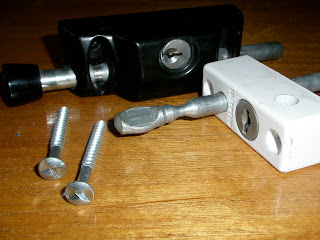Welcome...
My name is John and this is the first of hopefully many posts dealing with building maintenance and history.
This week has been fairly typical with the usual requests for repairs, installations and problem solving. Less common has been the significant number of requests for new locks or general assistance with locking problems and doors. For this reason I think it apt for this first blog to focus on security fixtures. The same locking issues are common to both large homes and small flats. Regardless of price or apparent complexity all locks do one thing, they place a solid bolt or bar into a fixed housing preventing the door or window from being moved. Simple right?
No matter how strong or complex the lock may be it is only as strong as the material it is mounted to. To put it another way, even the best lock will be inherently weak when screwed into soft wood and this essentially means your security is down to the holding ability of a few screws.
In most cases, doors and door jams (the timber surrounding the door opening) are made from hard woods but soft woods were and are still used on many doors and surrounding architraves such as the attractive, grainy, red-pine commonly used on Californian Bungalow style houses and flats from the 1920s and 1930s.
 |
| Red Pine door circa 1923 |
Should your entrance door contain glass or be of semi core construction then the security factor is understandably reduced. My point here is not to alarm but to bring a little common sense to the problem. Think about what you want from your lock and where it is to be fitted. As with most things, I suggest quality and not quantity is the answer. A common occurrence with new tenants or property owners is to fit additional new locks. I understand the reasoning but consider this, each time a lock is fitted more significant holes are placed in a perhaps already compromised door. One apartment I visited this week had four locks attached to the entrance door, some lacked keys others had simply never worked properly. Unfortunately the solution at each stage was to fit an additional one.
Entrance door severely weakened by additional lock
I am not a locksmith or security advisor but if you want to replace a lock, I recommend you do so in the existing original position. Holes generally conform to two sizes and you can readily find a quality replacement to match the original, measure the hole or take a photo or (preferably) the lock itself to your supplier. An even simpler solution is to keep the body of the original lock but replace its barrel (the cylinder where the key slides in). Replacing entire locks or simply the barrel also gives you the opportunity to match the keys. Really, who wants to carry around more keys? Think about having front and rear doors keyed alike. In many cases you can even have the same key fit your window locks. Only one key? Yes, it is possible, so please think before running out to buy that shiny new lock.
A selection of replacement lock cylinders
On the topic of window locks you may not be surprised to know that the same apartment had not one but three locking bolts on the one sash window. The reason is only too common and extremely infuriating... missing keys. In this instance the keys went missing whilst the window was unlocked and the solution on both occasions had been to fit a replacement. They could not remove the pointless locks as all had been installed with one-direction security screws meaning they can’t be unscrewed.
Please think very carefully about window locks and locking bolts there are many varieties and makes on the market and I have had to remove quite a number of them when keys are misplaced. In the worse case scenario this means grinding them off and a particularly noisy and dusty business it is, not to mention the unavoidable damage to the surrounding timber and paintwork.
 |
Familiar brand name window and door locks Note the one-way security screws |
Keyed window locks or bolts only prevent an intruder from opening the window once they are inside thereby hampering their efforts to remove goods. Their usage is widespread and growing possibly due to some insurance companies requiring them for household content coverage. Certainly make sure your windows can be fastened but if you do fit additional locking bolts to windows and sliding doors make a note of the key and/or barrel serial numbers so you can always obtain a replacement.
Lastly some words about getting the details right.
Please consider the styling and appearance of your locks. This may sound trite but I have seen many well designed and built dwellings marred by faulty and thoughtless fittings. This is doubly inexcusable when dealing with heritage or significant architecture. Please match the lock to the surrounds, do use the original mounting positions. If you are fitting a new entrance door in an apartment block make sure it and the lock and handle heights conform to those surrounding it and make note of the finish, is it brass, bronze, chrome or steel?



